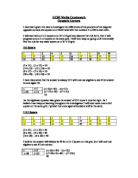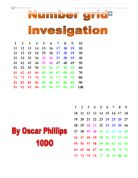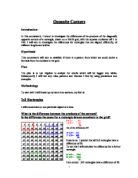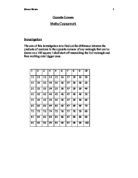Opposite Corners. In this coursework, to find a formula from a set of numbers with different square sizes in opposite corners is the aim. The discovery of the formula will help in finding solutions to the tasks ahead as well as patterns involving Opposite
Introduction: The mathematical investigations that are about to be undertaken are all under one puzzle called Opposite Corners. In this coursework, to find a formula from a set of numbers with different square sizes in opposite corners is the aim. The discovery of the formula will help in finding solutions to the tasks ahead as well as patterns involving Opposite Corners. There are a few basic procedures to follow to achieve a basic understanding of the whole puzzle. A box consisting of numbers from 1 to 100, a 10 by 10 grid (arranged in a regular pattern) will aid in initiating an understanding for this piece. Procedure: . Place borders of four lines in order to enclose numbers arranged in a given grid. The enclosed numbers should form a perfect square. 2. Multiply the numbers that are found diagonally opposite and placed in the four corners of the box. 3. From the products obtained after multiplying, find the difference between them. An example is demonstrated on the next page. Below is a 10 by 10 grid. Here the numbers are arranged in 10 columns. 2 3 4 5 6 7 8 9 0 1 2 3 4 5 6 7 8 9 20 21 22 23 24 25 26 27 28 29 30 31 32 33 34 35 36 37 38 39 40 41 42 43 44 45 46 47 48 49 50 51 52 53 54 55 56 57 58 59 60 61 62 63 64 65 66 67 68 69 70 71 72 73 74 75 76 77 78 79 80 81 82 83 84 85
I am going to investigate by taking a square shape of numbers from a grid, and then I multiply the opposite corners to find the difference of these two results. Firstly I am going to start with a 10x10 grid
Gcse Math's - number grid coursework I am going to investigate by taking a square shape of numbers from a grid, and then I multiply the opposite corners to find the difference of these two results. Firstly I am going to start with a 10x10 grid and pick up 4 different squares, I will start with the 2x2 square. Then I move on and use the 3x3, 4x4 and the 5x5 square. number Left corner x right corner Right corner x left corner Products difference 3x24=312 4x23=322 0 2 4x25=350 5x24=360 0 3 25x36=900 26x35=910 0 I have noticed that the products difference of 2x2 squares in a 10x10 grid equal to 10. I predict if I move the 2x2 square to the right or down I will get the same answer. 4 34x45=1530 35x44=1540 0 My prediction is right. I am going to use algebra to test my results. n n+1 n+10 n+11 (n+1)(n+10)=n²+10+11n n(n+11)=n²+11n Products difference is equal to (n²+10+11n) - (n²+11n) =10 In the same grid I will now work out a 3x3 square. number Left corner x right corner Right corner x left corner Products difference 5 5x37=555 7x35=595 40 6 6x24=144 4x26=104 40 7 6x38=608 8x36=648 40 I have noticed that the products difference of 3x3 squares in a 10x10 grid equal to 40. I predict if I move the 3x3 square to the right or up I will get the same answer. 8 26x48=1248 28x46=1288 40 My prediction is right. I am going to
Opposite Corners of a Square on a Number Grid
Number Grid - Opposite Corners Investigation Introduction: This task involves pupils investigating the relationship between the results, when diagonally opposite numbers in various sizes of squares are multiplied, and comparing the products. Number Grid - Opposite Corners Investigation Method: . I will use a number grid from 1-100, like the one below, to collect examples of data from different size squares. 2. I will show 4 examples of each size of squares, to confirm each of the differences at the different stages. 3. I will look for a pattern and, if I find one, will explain it fully. 4. I will make a prediction of what I think will happen next and see if it works. 5. I will create an algebraic expression to prove my results. 6. I will then test my algebraic expression on the diagonally opposite corners a rectangle, to see if that works as well. 7. I will then describe the sequence and relationship of the results. 8. I will present my results in a table and write a conclusion. Prediction: I predict that there will be a relevant relationship between the size of the box and the difference in results of the opposite corners. I think there will be a pattern, and an algebraic expression, which will work for all the box sizes. I think this investigation will be one in which you could branch off into many different sections. I think there will be a lot to explore and
Opposite Corners Maths investigation.
Opposite Corners Maths investigation Introduction For this investigation I am going to try and develop a formula to work out the difference between the products of the numbers in the opposite corners of any rectangle that can be drawn on a 10 x 10 grid composing of 100 squares. I shall use tables to present my findings; I shall be making predictions and proving my predictions right or wrong with examples. I will be using algebra to prove any of the rules I manage to create by analysing my results. Method To begin with I shall first find the difference between the products of the numbers in the opposite corners of 2x3 rectangles. . 34 x 26 = 884 24 x 36 = 864 20 Do all 2x3 rectangles have a difference of 20? 2. 58 x 50 = 2990 48 x 60 = 2880 20 It appears that they do. I predict that all 2x3 rectangles have a difference of 20. To prove this I shall calculate the difference between the products of the number in the opposite corners of one more 3x2 rectangle. 3. 85 x 77 = 6545 75 x 87 = 6525 20 Yes, it appears my prediction is correct. All 2x3 rectangles on the grid have a difference of 20. However what if the rectangle is aligned differently on the grid, so the shorted sides are at the top and bottom? Will the difference for that still be 20? . 46 x 65 = 2990 45 x 66 = 2970 20 Nope, it is still 20. I will now try rectangles with the same height of two,
My course work in maths is going to consist of opposite corners and/or hidden faces.
My course work in maths is going to consist of opposite corners and/or hidden faces. For my first course in mathematics I have been given the task of investigating the difference between the products of the numbers in the opposite corners of my rectangle that can be drawn on a 10 by 10 square. I will start off by showing some examples of different rectangles and what the sum of the corners will be. This will help me to determine whether or not there is a pattern. Example 2 3 4 5 6 7 8 9 0 1 2 3 4 5 6 7 8 9 20 21 22 23 24 25 26 27 28 29 30 31 32 33 34 35 36 37 38 39 40 41 42 43 44 45 46 47 48 49 50 51 52 53 54 55 56 57 58 59 60 61 62 63 64 65 66 67 68 69 70 71 72 73 74 75 76 77 78 79 80 81 82 83 84 85 86 87 88 89 90 91 92 93 94 95 96 97 98 99 00 1* 12=12 2* 11=22 22-12=10 This example shows us that between the squares 1,2,11,12 the sum will be 10. We will now go on to see what a square between 1,2,21,22 will be. Example 2 3 4 5 6 7 8 9 0 1 2 3 4 5 6 7 8 9 20 21 22 23 24 25 26 27 28 29 30 31 32 33 34 35 36 37 38 39 40 41 42 43 44 45 46 47 48 49 50 51 52 53 54 55 56 57 58 59 60 61 62 63 64 65 66 67 68 69 70 71 72 73 74 75 76 77 78 79 80 81 82 83 84 85 86 87 88 89 90 91 92 93 94 95
I am going to investigate taking a square of numbers from a grid, multiplying the opposite corners and finding the difference of these two results. To start I used a 5x5 grid:
Maths Coursework Number Grids I am going to investigate taking a square of numbers from a grid, multiplying the opposite corners and finding the difference of these two results. To start I used a 5x5 grid: 2 3 4 5 6 7 8 9 0 1 2 3 4 5 6 7 8 9 20 21 22 23 24 25 Then I took 2x2 squares out of this grid and multiplied the opposite corners, to find the difference: 2 6 7 x 7 = 7 2 x 6 = 12 2 - 7 = 5 So the difference between the answers is 5. Next I took another 2x2 square from the same grid. 9 20 24 25 9 x 25 = 475 20 x 24 = 480 480 - 475 = 5 The difference is 5 again. I thought this could mean that all 2x2 squares in a 5x5 grid would come out with a difference of 5. To check this, I took another 2x2 square out of the grid to check. 2 3 7 8 2 x 18 = 216 3 x 17 = 221 221 - 216 = 5 So this shows that my prediction was right and every 2x2 square in a 5x5 grid should come out with a difference of 5. Any 2x2 square in a 5x5 grid = Difference of 5 Now I am going to start taking 2x2 squares out of a 6x6 grid. 2 7 8 x 8 = 8 2 x 7 = 14 4 - 8 = 6 The difference is 6. 21 22 27 28 21 x 28 = 588 22 x 27 = 594 594 - 588 = 6 Again the difference is 6. So I can see like in the 5x5 grid there is a pattern. If I am right every 2x2 square in a 6x6 grid should have a difference of 6. To check if I am right I will take one more square
opposite corners
GCSE Maths Coursework Opposite Corners I have been given the task to investigate the differences of the products of the diagonal opposite corners of a square on a 10x10 Grid with the numbers 1 to 100 to start with. I will start with a 2 x 2 square on a 10 x 10 grid and discover the rule for it, then I will progress onto a 3 x 3 square on the same grid. I will then keep on going until I eventually find the rule for any sized square on a 10 x 10 grid. 2x2 Square 2 3 4 5 6 7 8 9 0 1 2 3 4 5 6 7 8 9 20 21 22 23 24 25 26 27 28 29 30 (2 x 11) - (1 x 12) = 10 (14 x 25) - (15 x 24) = 10 (8 x 17) - (7 x 18) = 10 (20 x 29) - (19 x 30) = 10 I have discovered that the answer is always 10 I will now use algebra to see if the answer is once again 10. n n+1 n+10 n+11 (n+1)(n+10) - n(n+11) (n2+11n+10) - (n2+11n) 0 As the algebraic equation also gives the answer of 10 I know it must be right. As I believe I can keep on learning throughout the investigation I will now move onto a 3x3 square on the same grid. I predict that once again all answers will be the same. 3 X 3 Square 2 3 4 5 6 7 8 9 0 1 2 3 4 5 6 7 8 9 20 21 22 23 24 25 26 27 28 29 30 (3 x 21) - (1 x 23) = 40 (6 x 24) - (4 x 26) = 40 (10 x 28) - (8 x 30) = 40 I believe the answer will always be 40 for a 3 x 3 square on this grid. So I will now use algebra
Opposite Corners.
Opposite Corners Investigation: Given a 100 Square, I am to investigate the difference between the products of the numbers in the opposite corners of any rectangle that can be drawn on the 100 square. 2 3 4 5 6 7 8 9 0 1 2 3 4 5 6 7 8 9 20 21 22 23 24 25 26 27 28 29 30 31 32 33 34 35 36 37 38 39 40 41 42 43 44 45 46 47 48 49 50 51 52 53 54 55 56 57 58 59 60 61 62 63 64 65 66 67 68 69 70 71 72 73 74 75 76 77 78 79 80 81 82 83 84 85 86 87 88 89 90 91 92 93 94 95 96 97 98 99 00 2x3 A rectangle has been highlighted in the 100 square 1 and 13/11 and 3 are the numbers in the opposite corners product of the number in these opposite corners are x13=13 1x3=33 The difference between these products is 33-13= 20 A rectangle has been highlighted in the 100 square 4 and 16/14 and 6 are the numbers in the opposite corners product of the number in these opposite corners are 4x16=64 4x6=84 The difference between these products is 84-64= 20 A rectangle has been highlighted in the 100 square 7 and 19/17 and 9 are the numbers in the opposite corners product of the number in these opposite corners are 7x19=133 7x9=153 The difference between these products is 153-133=20 Conclusion: I have Concluded that my prediction was correct and that a 2 by 3 rectangles have a




















